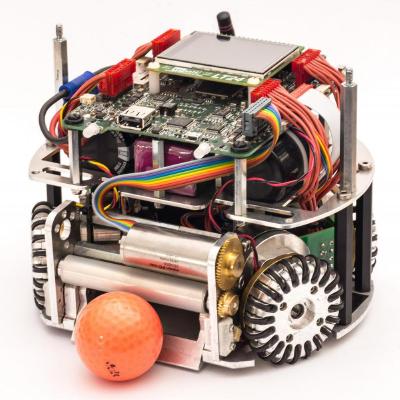TIGERs Mannheim
Dear SSL-community,
as in the past years we are very happy to announce our entry for the
Open Source Award. We are celebrating 10 years of TIGERs Mannheim with a
complete and full release of everything we have, including electronics,
mechanics, and our full AI.
Below, you will find a list of our publications. The documentation or
description is included within the individual packages.
Mechanics:
A completely redesigned robot, higher power motors, more computer power,
more sensors (incl. cameras) and much more.
https://download.tigers-mannheim.de/releases/2019/Mechanics-2019.zip
Electronics:
A mechanically new robot of course comes with a lot of new electronic
boards.
https://download.tigers-mannheim.de/releases/2019/Electronics-2019.zip
Firmware:
And also a new firmware for our new STM32H7 primary microcontroller and
STM32F0 sub-processors:
https://download.tigers-mannheim.de/releases/2019/Firmware-2019.zip
Software (AI):
The heart and brain of our team, the central control software Sumatra.
Available as download:
https://download.tigers-mannheim.de/releases/2019/Software-2019.tar.gz
And on Github: https://github.com/TIGERs-Mannheim/Sumatra
In case you are missing any information or if you are just curios, come
by and let’s have a chat or write us an email.
Tigertastic Greetings,
TIGERs Mannheim
RoboJackets
Dear SSL community,
This year RoboJackets has started outsourcing our mechanical designs. Additionally, we are continuing our tradition of open sourcing our software, firmware, and PCB designs through GitHub. This year we have added a new project: A fully open source microcontroller board based on the Cortex M7 with an emphasis on being small enough to easily fit within small size league robots.
Mechanical
Robot CAD: https://github.com/RoboJackets/robocup-mechanical
Electrical
Robot Boards: https://github.com/RoboJackets/robocup-pcb
Microcontroller Board: https://github.com/RoboJackets/mtrain-pcb
Software
GUI and High Level Control: https://github.com/RoboJackets/robocup-software
Firmware: https://github.com/RoboJackets/robocup-firmware
Microcontroller HAL: https://github.com/RoboJackets/mtrain-firmware
Best Regards,
RoboJackets
ZJUNlict
Dear SSL community,
As you may already know, we have open-sourced our electronics in January. Besides that, we would also like to share our mechanical design and vision process software. We hope these can help the SSL community. Detailed design specification and software guide can be found in the corresponding github repository listed below.
Mechanics (Include 3D Design Files)
https://github.com/ZJUNlict/Mechanics
The mechanical design emphasizes on crash protection, maintainability and simplicity. The dribbler design is thoroughly explained.
Electronics (Include Schematics, PCBs and Related Firmware)
https://github.com/ZJUNlict/Electronics
The design files are up-to-date. We also present the transition of design from 2012 to 2019 which may provide other teams a practical way to progress.
Software (mAn – Vision Process and GUI)
https://github.com/ZJUNlict/mAn
mAn is the main GUI of ZJUNlict. It also processes the vision and referee information (protobuf messages).
Looking forward to see you all in Sydney!
Best wishes,
ZJUNlict
